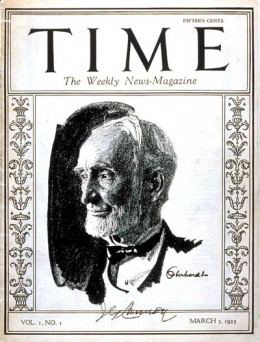
A couple of smart kids thought it would be fun to start a magazine, and with the issue dated March 3, 1923, they did. When TIME began, Briton Hadden had just turned 25; Henry R. Luce would reach that august age a month later. They had met as teenagers at the Hotchkiss School, where Hadden, the son of a Brooklyn banker, was the chairman (editor) of the biweekly journal the Hotchkiss Record, and Luce, born in Tengchow, China, to Presbyterian missionary parents, was assistant managing editor. At Yale Hadden served as chairman and Luce managing editor of the campus Daily News. In 1921, while both worked for the Baltimore News, they hatched the idea for a magazine that now celebrates its 90th birthday. They wanted to call it Facts.
Someone came up with a better name: TIME. As in: if you read it, you’ll save it. Haddon and Luce had the wildly ambitious notion of presenting, in one 28-page package (including six pages of ads), everything they thought an intelligent person needed to know about the week’s national, international, financial and cultural events. They divided the magazine into sections, each with a plethora of short, pertly written items of news or opinion. To their prospective backers and advertisers, Hadden and Luce boasted that an alert reader could get through the whole thing in 30 mins. “It was of course not for people who really wanted to be informed,” wrote W.A. Swanberg somewhat sourly in his 1972 study Luce and His Empire. “It was for people willing to spend a half-hour to avoid being entirely uninformed.” But there were enough of those people to make the venture an instant — and, we may say, lasting — success.
TIME may be the weekly newsmagazine, but it was not the first. The Literary Digest, founded in 1890 by another pair of school chums, Isaac Funk and Adam Wagnalls of Wittenberg College, had long culled news stories and editorials from the nation’s papers. In the ’20s it was selling a million copies weekly; its popularity may have inspired DeWitt and Lila Wallace to launch their Reader’s Digest, a compendium of general-interest nonfiction, in 1922. TIME eventually overtook The Literary Digest in circulation, and in 1938, when Funk and Wagnalls’ magazine ceased publication. TIME bought its subscription list.
What TIME had that The Literary Digest lacked was a contemporary attitude. While Luce cannily built the business, Hadden, the first editor and a true Jazz Age bon vivant, stamped the magazine with the fresh, nearly impudent voice he had honed at Hotchkiss and Yale. Not content with rewriting news stories, Hadden and Luce infused them with wit, sauce, a certain collegiate breeziness, that made TIME as entertaining as it was informative. In his six years as editor, before dying in 1929, at 31, of septicemia, Hadden developed the distinctive “TIMEstyle” — a mix of piquant words (“tycoon,” from the Japanese), complex adjectives (“beetle-browed,” from the classical Greek) and transposed word order — that was widely imitated and mercilessly parodied. “Backward ran sentences until reeled the mind,” wrote Wolcott Gibbs in a 1936 New Yorker critique of the magazine, “Where it will all end, knows God.”
But when it all began, the verbal playfulness was still relatively muted. Concision was all, with the stories compressed into a black hole of text. In this first issue, the Nation section contained 32 items, World 32, Business eight, Education four, Law three, Arts and Entertainment — Books, Theater, Music, Art and The New Pictures — 14. The cover story, on 86-year-old Republican Party leader Joseph “Uncle Joe” Cannon, formerly Speaker of the House, ran a brisk 311 words. A theater review of a Broadway double bill starring Konstantin Stanislawski was nearly as long: 275 words.
Some items from the first TIME read like harbingers of today’s political news. Senators defeated President Harding’s Ship Subsidy bill through a “Death by Filibuster”: they orated in five- or six-hour stretches. The Congress also debated an immigration bill, which would give preference to northern Europeans and “exclude Japanese and low-caste Hindus.” (“Labor wants immigration cut to a minimum. So-called ‘Big Business’ wants immigration increased.”) And the first movie review, of Cecil B. De Mille’s Adam’s Rib, sings with the merry scorn of a modern critic, but in 25 words or less: “An expensive, elaborate hash of cavemen, foreign revolutions, ex-kings, the Chicago wheat-pit in a state of acute neurasthenia, flappers, wayward mothers, and hokum.”
The Milestones page, still thriving after 90 years, marked notable births, deaths and… “Sued for Divorce: Mrs. Elizabeth Fae Furness, an American, by Thomas Furness, brother of Viscount Furness. Maurice, the dancer, is named as corespondent.” A section called Miscellany (“TIME brings all things”) collected such oddities as “In Asbury Park, N. J., a young lady hiccoughed steadily for twelve weeks; then ceased as suddenly as she began.” Two departments pointed readers toward stories in the current issue: Point With Pride (“The first successful helicopter [P. 21]”) and View With Alarm (“The attempt of a partly blind youth to make money by a partly blind pig [P. 19]”).
Over the decades, pages increased and stories got longer. Luce’s editors and writers generated their own stories, rather than synopsizing the work of others, and a worldwide network of correspondents brought depth and piquancy to the week’s news. TIME’s Business section spawned the monthly journal Fortune, in 1930; the People page (“Names make news”), which first appeared in 1932, evolved into its own popular weekly in 1974. But the basic structure of that first TIME — news divided into 14 to 20 departments that ran weekly or intermittently — remained intact until the magazine’s 1992 redesign and exists in modified form today.
Browse electronically through the March 3, 1923, issue (viewable on TIME‘s iPad edition), and you will see the bright-eyed newborn — loud, happy and precocious — that quickly and sturdily grew into the world’s leading newsmagazine.

